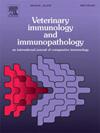Co-infections with Bordetella bronchiseptica in canine: A systematic review and meta-analysis
IF 1.4
3区 农林科学
Q4 IMMUNOLOGY
引用次数: 0
Abstract
Background
Bordetella bronchiseptica is a primary pathogen in canine infectious respiratory disease (CIRD), or kennel cough, capable of independently causing respiratory illness and contributing significantly to co-infections with other viral and bacterial agents. Despite its critical role in disease transmission and persistence, the epidemiology of B. bronchiseptica in CIRD remains poorly understood. Limited data on co-infection prevalence and associated risk factors hinder effective management and control of this pathogen.
Objective
This systematic review and meta-analysis aimed to clarify the prevalence and risk factors of co-infections with B. bronchiseptica in dogs.
Methods
A comprehensive bibliographic search was conducted across four databases: PubMed, Scopus, Web of Science, and Embase. Data extraction included the number of co-infected cases among those with B. bronchiseptica, the identified co-infecting pathogens, study period, geographical location, shelter type, and age.
Results
From 3994 identified articles, 26 studies were included. The overall prevalence of B. bronchiseptica co-infection was 47 % (95 % CI: 37 %-57 %). Significant differences were observed only in the study period, with co-infection rates higher in the 1900s (77 %) compared to the 2000s (45 %). No significant differences were found for other factors. Frequently co-infecting pathogens included Mycoplasma and canine respiratory coronavirus (CRCoV).
Conclusion
Co-infections with B. bronchiseptica are common in CIRD, indicating a need for the development of combined vaccines targeting co-infecting pathogens. Furthermore, the establishment of effective prevention and control strategies can be universally applied across different geographical locations, shelter types, and ages. This study provides valuable insights that can inform future research and enhance the overall management and treatment of CIRD in dogs.
犬与支气管脓毒杆菌合并感染:系统综述和荟萃分析。
背景:支气管脓毒杆菌是犬传染性呼吸道疾病(CIRD)或犬舍咳嗽的主要病原体,能够独立引起呼吸道疾病,并与其他病毒和细菌病原体共同感染。尽管它在疾病传播和持续中起着关键作用,但对CIRD中支杆菌的流行病学仍然知之甚少。关于合并感染流行率和相关危险因素的有限数据阻碍了对这种病原体的有效管理和控制。目的:本系统综述和荟萃分析旨在阐明犬支杆菌感染的患病率和危险因素。方法:在PubMed、Scopus、Web of Science和Embase四个数据库中进行全面的书目检索。数据提取包括结核分枝杆菌合并感染的病例数、确定的合并感染病原体、研究时间、地理位置、庇护所类型和年龄。结果:从3994篇鉴定文章中,纳入26篇研究。结核分枝杆菌合并感染的总体患病率为47 %(95 % CI: 37 %-57 %)。仅在研究期间观察到显著差异,20世纪初的合并感染率(77 %)高于21世纪初(45 %)。其他因素无显著差异。常见的共感染病原体包括支原体和犬呼吸道冠状病毒(CRCoV)。结论:在CIRD中合并支杆菌感染是常见的,表明有必要开发针对合并感染病原体的联合疫苗。此外,建立有效的预防和控制策略可以普遍适用于不同的地理位置,庇护所类型和年龄。该研究提供了有价值的见解,可以为未来的研究提供信息,并加强犬CIRD的整体管理和治疗。
本文章由计算机程序翻译,如有差异,请以英文原文为准。
求助全文
约1分钟内获得全文
求助全文
来源期刊
CiteScore
3.40
自引率
5.60%
发文量
79
审稿时长
70 days
期刊介绍:
The journal reports basic, comparative and clinical immunology as they pertain to the animal species designated here: livestock, poultry, and fish species that are major food animals and companion animals such as cats, dogs, horses and camels, and wildlife species that act as reservoirs for food, companion or human infectious diseases, or as models for human disease.
Rodent models of infectious diseases that are of importance in the animal species indicated above,when the disease requires a level of containment that is not readily available for larger animal experimentation (ABSL3), will be considered. Papers on rabbits, lizards, guinea pigs, badgers, armadillos, elephants, antelope, and buffalo will be reviewed if the research advances our fundamental understanding of immunology, or if they act as a reservoir of infectious disease for the primary animal species designated above, or for humans. Manuscripts employing other species will be reviewed if justified as fitting into the categories above.
The following topics are appropriate: biology of cells and mechanisms of the immune system, immunochemistry, immunodeficiencies, immunodiagnosis, immunogenetics, immunopathology, immunology of infectious disease and tumors, immunoprophylaxis including vaccine development and delivery, immunological aspects of pregnancy including passive immunity, autoimmuity, neuroimmunology, and transplanatation immunology. Manuscripts that describe new genes and development of tools such as monoclonal antibodies are also of interest when part of a larger biological study. Studies employing extracts or constituents (plant extracts, feed additives or microbiome) must be sufficiently defined to be reproduced in other laboratories and also provide evidence for possible mechanisms and not simply show an effect on the immune system.

 求助内容:
求助内容: 应助结果提醒方式:
应助结果提醒方式:


